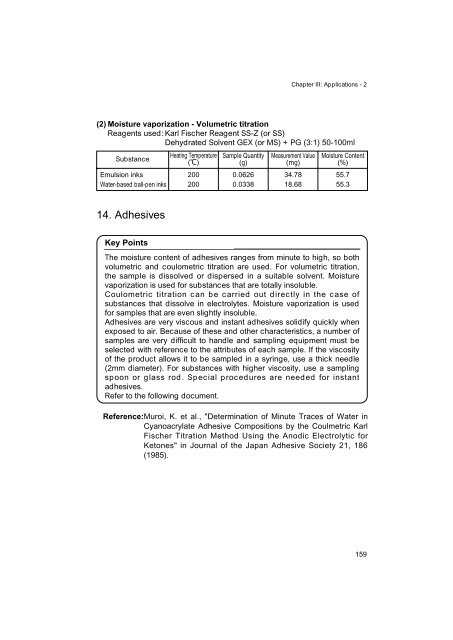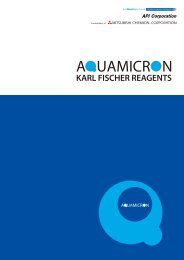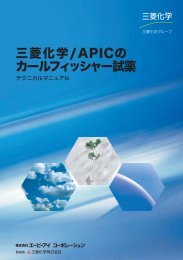Development of Karl Fischer Reagents
Development of Karl Fischer Reagents
Development of Karl Fischer Reagents
You also want an ePaper? Increase the reach of your titles
YUMPU automatically turns print PDFs into web optimized ePapers that Google loves.
Chapter III: Applications - 2<br />
(2) Moisture vaporization - Volumetric titration<br />
<strong>Reagents</strong> used: <strong>Karl</strong> <strong>Fischer</strong> Reagent SS-Z (or SS)<br />
Dehydrated Solvent GEX (or MS) + PG (3:1) 50-100ml<br />
Substance<br />
Emulsion inks<br />
Water-based ball-pen inks<br />
14. Adhesives<br />
Key Points<br />
Heating Temperature<br />
( � C)<br />
200<br />
200<br />
Sample Quantity<br />
(g)<br />
0.0626<br />
0.0338<br />
Measurement Value<br />
(mg)<br />
34.78<br />
18.68<br />
Moisture Content<br />
(%)<br />
55.7<br />
55.3<br />
The moisture content <strong>of</strong> adhesives ranges from minute to high, so both<br />
volumetric and coulometric titration are used. For volumetric titration,<br />
the sample is dissolved or dispersed in a suitable solvent. Moisture<br />
vaporization is used for substances that are totally insoluble.<br />
Coulometric titration can be carried out directly in the case <strong>of</strong><br />
substances that dissolve in electrolytes. Moisture vaporization is used<br />
for samples that are even slightly insoluble.<br />
Adhesives are very viscous and instant adhesives solidify quickly when<br />
exposed to air. Because <strong>of</strong> these and other characteristics, a number <strong>of</strong><br />
samples are very difficult to handle and sampling equipment must be<br />
selected with reference to the attributes <strong>of</strong> each sample. If the viscosity<br />
<strong>of</strong> the product allows it to be sampled in a syringe, use a thick needle<br />
(2mm diameter). For substances with higher viscosity, use a sampling<br />
spoon or glass rod. Special procedures are needed for instant<br />
adhesives.<br />
Refer to the following document.<br />
Reference: Muroi, K. et al., "Determination <strong>of</strong> Minute Traces <strong>of</strong> Water in<br />
Cyanoacrylate Adhesive Compositions by the Coulmetric <strong>Karl</strong><br />
<strong>Fischer</strong> Titration Method Using the Anodic Electrolytic for<br />
Ketones" in Journal <strong>of</strong> the Japan Adhesive Society 21, 186<br />
(1985).<br />
159




